Cracking down on wildlife trafficking Understand article
Biologist Juliana Machado Ferreira is using science to combat wildlife traffickers in Brazil.
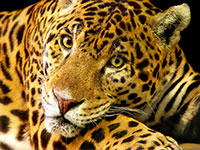
Brazilian illegal wildlife trade
Image courtesy of Bjørn
Christian Tørrissen; image
source: Wikimedia Commons
The illegal wildlife trade in Brazil is one of the main threats to the country’s fauna, explains biologist Juliana Machado Ferreira. It is estimated that each year 38 million animals, mainly birds, are removed from their natural habitats in Brazil to be sold for a variety of different purposesw1. This illegal market is estimated to be worth US$2 billion per year.
“There are four main categories of illegal wildlife trade in Brazil,” explains Juliana. The first is for products and souvenirs: for example, items made with turtle shells, teeth, claws, feathers, fur and skin. The second category is for use in traditional medicines. “People think that the craziest things will cure them or even make them more sexually active,” says Juliana. “For instance, in Brazil, the genitalia of river dolphins are very sought after, because people think that they will attract love.”
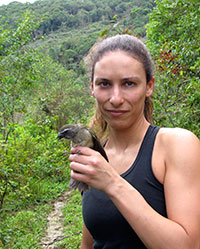
saltator (Saltator similis),
which she is about to release
Image courtesy of Marcos
Antonio Melo
The third is bio-piracy: the unfair exploitation of Brazil’s biodiversity and local knowledge. “Local people may know which kinds of plants or animals will cure them of an inflammation or other health problem,” she explains. “Pharmaceutical and cosmetic companies sometimes exploit this knowledge, and once they have learned that traditional people use, for example, a frog’s poison to treat an inflammation, they smuggle the frog or the poison back to the lab.” There, attempts are made to identify and then synthesise the active molecule – the molecule responsible for the anti-inflammatory activity. “They then patent it and sell the very, very expensive results back to us as medicine.” Such practices contravene the 2010 agreement in Nagoya, Japan, by the Convention on Biological Diversity, which states that the benefits arising from the use of genetic resources should be shared in a fair and equitable wayw2 (Rau, 2010).
The fourth and largest category of illegal wildlife trade in Brazil is to supply the pet market. “In Brazil, birds are the most sought-after group because it’s part of our culture to have song birds, macaws and parrots in cages at home,” she says. Other animals stolen for this purpose include fish, reptiles, amphibians, spiders and small mammals. Some species of pet can be purchased legally from commercial breeders, but the illegal market is still extremely large.
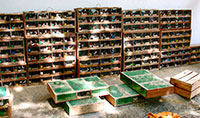
police station, immediately
after a lorry carrying 4000
trafficked animals was
seized by the São Paulo state
police and SOS Fauna
Image courtesy of SOS Fauna
“One reason is that animals bred in captivity are always more expensive than ones caught from nature,” Juliana explains. The animals are captured all over Brazil and sold mainly in large cities such as Rio de Janeiro and São Paulo.
The other reason why the problem is particularly large in Brazil, says Juliana, is because of weak environmental legislation. It can be hard for the authorities to prove that animals are illegal, and traffickers only have to pay small fines if they are caught.
Even when the police do seize illegally trafficked animals, the question remains of what to do with them. There are government assessment and rehabilitation centres, but the scale of the problem – in 2002 alone, 45 000 animals (of which 37 000 were birds) were received by these centres – means they are very costly to run. Currently, the ‘solution’ proposed by the Brazilian Ornithological Society is to euthanise all animals from non-endangered species, which Juliana strongly opposes. The alternative to mass euthanasia or keeping the animals in centres for the rest of their lives is to return them to the wild.
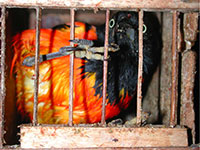
the São Paulo state police
and SOS Fauna, still in the
box it had been trafficked in
Image courtesy of SOS Fauna
In the past this has been deemed too risky, for both the released animal and the natural habitat. But the work of Juliana and her peers shows that re-release is possible. This isn’t a new idea globally, notes Juliana, but in Brazil it is still a big issue.
Where should the rescued birds be released, though? Is it important (or even possible) to return individual birds to the area that they came from, or could they be released into any suitable habitat? The answer depends on the ecology, behaviour and genetics of the species, in particular on how isolated and differentiated the populations of that species are.
When populations are isolated from each other and their environments differ, they can evolve significant local adaptations. For example, chicks need to hatch at a time when food is plentiful, so in colder regions they will normally hatch later in the year than in warmer regions. The populations may also evolve what are known as co-adapted gene complexes: groups of gene variants that work well together, but not as well when mixed with other variants of the same genes.
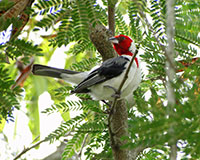
Image courtesy of Dilson
Santos; image source: Flickr
If rescued birds from one isolated population are released to breed with individuals from another population, the result may be outbreeding depression in subsequent generations. This can result either from a disruption in biological cycles (e.g. the chicks hatching before there is enough food available) or from the co-adapted gene complexes being broken up during genetic recombination. Either of these outcomes will make the birds less able to survive in their environment.
In contrast, if populations of a species are not isolated and their behaviour, ecology and genetics are very similar, releasing individuals into the ‘wrong’ population is unlikely to cause genetic problems.
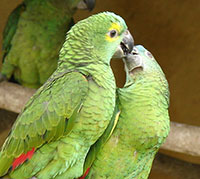
that were seized by the São
Paulo highway patrol in 2006
and arrived at SOS Fauna as
chicks. The parrots are now
fully rehabilitated and were
taken to the release site in
July 2012. They will stay in
acclimation for a month and
should be released in mid-
August 2012
Image courtesy of SOS Fauna
During her recently completed PhD, Juliana investigated the genetic similarity between populations – and thus the likelihood of outbreeding depression if individuals are released into the wrong population – of two exploited bird species: Paroaria dominicana(the red-cowled cardinal) and Saltator similis (the green-winged saltator). She travelled all over Brazil to collect blood samples from birds in different areas and then studied their genomes to see if an individual bird’s origin could be identified. Instead of looking at the whole genome (which would largely be the same for every bird sampled), Juliana focused on sections of the genome that are highly variable and evolving very quickly
Her first task was to identify these highly variable regions. “I had to find these hypervariable regions in each species’ genome,” Juliana explains.
She did this by breaking up the genomes of the birds into small pieces and placing them in bacteria. She then ‘fished’ for highly variable regions using probes of complimentary DNA strands. But how did Juliana know what type of genetic sequence to fish for in the first place? “One of the characteristics of these variable regions is that they have repetitive units,” she explains. “So we used probes that are repetitive as well, for example blocks of AGAGAGAG or GATAGATAGATA.” Once the highly variable sections had been identified, new probes that are more specific (called primers) could be designed so that these sections could be directly targeted in the future. (To learn more about the technique, see Müller & Göllner-Heibült, 2012.)
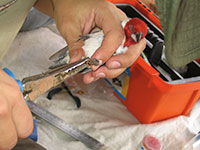
measures it, attaches a leg
band for identification, takes
a tiny blood sample,
disinfects the puncture site,
rehydrates the bird and then
releases it
Image courtesy of Erica Pacifico
Next, Juliana needed to collect blood samples from the two species of birds from all across Brazil to work out if the differences between the gene sequences in these highly variable sections of the genome were sufficient to allow a bird’s origin to be identified. To find the birds in each region, she would trek for miles playing a recording of a male bird’s song. “When a bird hears the song of the same species but coming from another individual, it goes crazy, as it needs to defend its territory,” she says. The bird is then captured using very fine nets, and tiny – microlitre sized – blood samples are taken, after which the puncture site is disinfected and the bird rehydrated before being returned to the wild.
Juliana collected samples from 10 different birds in each sample site and also received donations of museum tissue samples and blood samples from other researchers – from more than 500 birds in total.
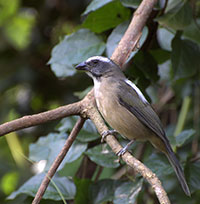
Image courtesy of Dario
Sanches; image source: Flickr
Once her collection was complete, Juliana returned to the lab to analyse the samples. “I went through a period of very intensive lab work during which I had to extract DNA from the blood samples, clean it and quantify it, and then – using a technique called the polymerase chain reaction (PCR), which mimics DNA replication – I increased the amount of only those fragments I was interested in,” Juliana explains. For the PCR, Juliana used the primers she had identified earlier to allow the correct part of the genome to be replicated.
Next, she looked for any differences between these specific sections of DNA in the individual birds.
This process is called genotyping. The differences Juliana was looking for were variations in the number of repeating units. As mentioned previously, these highly variable sections are blocks of repetitive units such as AGAGAGAG. “One person has (AG)3 while another may have (AG)7,” Juliana explains.
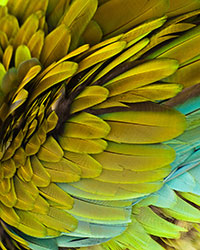
valuable commodity in the
Brazilian illegal wildlife trade
Image courtesy of BK Dewey;
image source: Flickr
Once each bird had been genotyped, Juliana used statistics to analyse the variation in the population across the whole of Brazil. “Some of the questions that could be answered were: how many different genetic groups are there in this sampling? Are they correlated to geography? How different are they? Are they isolated from each other? What is the within-group variability compared to the total variability?” she says.
On the basis of this information, Juliana was not able to tell where individuals of S. similis had come from. This means that her genetic analysis cannot be used to assign captured birds to their home population, but it also means that returning birds to the ‘wrong’ population should not cause genetic problems.
The situation for P. dominicana was a little different. Juliana was able to identify three major genetic groups that were correlated to distinct geographical areas. Although these groups were recognisable, they were not isolated: there were high levels of gene flow between them. So even though it is possible to tell roughly where captured birds had come from, there would be little likelihood of outbreeding depression if they were released elsewhere.
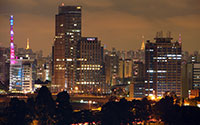
Paulo – areas of which are
hot spots for illegal wildlife
trafficking
Image courtesy of Diego3336;
image source: Flickr
During her PhD, Juliana was able to apply her research directly to the battle against illegal wildlife trafficking. “I was able to track the origin of 49 P. dominicana individuals seized in São Paulo; they were all part of the same genetic cluster,” she says. “This information corroborates what the police think is the most exploited region for this species.” As well as helping the authorities decide where to return the birds to, knowing the areas that are the most exploited allows efforts to be made there to prevent exploitation. Examples of possible actions include road blocks to check for traffickers leaving the area with wildlife, more environmental legislation and social work with the local communities, she explains.
It is these sorts of applications that first encouraged Juliana to enter conservation research, after she had spent years volunteering with the non-government organisation (NGO) SOS Faunaw3, working closely with its president, Marcelo Pavlenco Rocha. Through SOS Fauna, she attends raids to assist the police in identifying which species are legal to own, helps with release projects, and is a spokesperson against animal trafficking. More recently, she has established another NGO called Freeland Brasil. Through this organisation, Juliana is involved in making public policy, in projects to train people from different sectors on how they can combat wildlife trafficking, and in seeking funding to establish an independent wildlife forensics lab in Brazil.
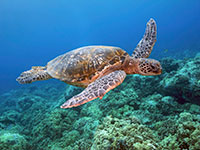
illegally in Brazil
Image courtesy of SteveD;
image source: Flickr
Juliana’s story demonstrates just how much one determined young person can achieve, with a great deal of devotion and effort. But surely we too can help to end wildlife trafficking? Juliana has two requests to all of us. First, remember that wild animals are not pets; if you want a pet, keep a domestic animal. Second, make sure you know the sources of the things that you buy, whether pets or wildlife-based products. “If you really need to have an animal or if you really need to buy that comb, find out whether it is from a legal breeder or a legal source,” she says. “Ask whether it is okay for them to be selling this tortoise-shell comb or that red coral necklace.”
Acknowledgement
This article is based on an interview given by Juliana Machado Ferreira to the editor-in-chief of Science in School, Dr Eleanor Hayes.
Juliana would like to thank her PhD advisor, Dr Joao Morgante, the US Fish and Wildlife National Forensics Laboratory and São Paulo State Police for their support. She is also grateful for the research funding from the Brazilian federal research funding agencies CAPES and FAPESP.
References
- Müller S, Göllner-Heibült H (2012) Genetic fingerprinting: a look inside. Science in School 22: 49-56.
- To learn about the lead-up to COP 10, the 10th meeting of the Convention on Biological Diversity, at which the Nagoya Protocol was agreed, see:
- Rau M (2010) Homo sapiens – an endangered species? Science in School 15.
Web References
- w1 – The extent of the illegal wildlife trade in Brazil was estimated by the NGO RENCTAS, the Brazilian national network to fight the trafficking of wild animals.
- w2 – Adopted in October 2010, the Nagoya Protocol on Access to Genetic Resources and the Fair and Equitable Sharing of Benefits Arising from their Utilization to the Convention on Biological Diversity is an international agreement which covers appropriate access to genetic resources and transfer of relevant technologies, taking into account all rights over those resources and to technologies.
- w3 – SOS Fauna is a non-governmental, non-profit organisation that works to defend and conserve the wildlife of Brazil.
Resources
- The Freeland Foundation is an international organisation dedicated to stopping human and wildlife trafficking.
- Inspired by the Freeland Foundation, Freeland Brasil is dedicated to preserving Brazil’s unique and important biodiversity.
- Traffic, the wildlife trade monitoring network, works to ensure that trade in wild plants and animals is not a threat to the conservation of nature.
- In 2010, Juliana Machado Ferreira gave an online lecture about her work to save birds and other animal stolen from the wild in Brazil.
- The Convention on International Trade in Endangered Species of Wild Fauna and Flora (CITES) is an international agreement between governments to ensure that the international trade in specimens of wild animals and plants does not threaten their survival.
Review
This article about the battle against illegal wildlife trafficking addresses a topic of social and political importance, involving many biological aspects such as ecology, molecular biology, genetic fingerprinting and population dynamics. It raises important questions about the exploitation of indigenous knowledge by pharmaceutical companies. At an everyday level, it can be related to the wish of many children to own a pet or to bring souvenirs back from their holidays.
Based on the article, class discussions could cover the politics of Brazil, the rights of local people, the impact of the wildlife trade, and how to control it. The text can also be used as an excellent example of how molecular biology is being applied to the conservation of endangered species.
- What are the four main categories of wildlife trafficking in Brazil?
- What solutions are offered in the article to combat wildlife trafficking?
- Which methods did Juliana use to discover the origin of the captured birds?
- Why may it be important to return rescued animals to the area they originated from?
- Describe the steps of Juliana’s work to investigate the genetics of the captured birds.
Friedlinde Krotscheck, Austria





